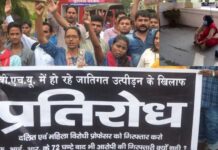7th August is celebrated as the National Handloom Day each year to acknowledge the contributions made by the weavers, artisans, and other workers involved in the handloom sector who make immense contributions in preserving Indigenous Art and Culture.
It was on this day in 1905 that the Swadeshi Movement was launched in Calcutta’s Town Hall against the partition of the Bengal presidency initiated by the British Colonial Government.
“Congress killed the sector in the name of Gandhi, BJP is doing the same thing in the name of Rama”- Prasanna
However, the BJP Government known for paying only lip-service with no real intent of bettering the lives of people has only recently abolished that All India Handloom Board and All India Handicrafts Boards on July 27th and August 3rd respectively and this is the first time that India is celebrating its National Handloom Day without the advisory boards in place.
The novel coronavirus disease (COVID-19) pandemic and the ensuing countrywide lockdown have only added to the problems of the sector.
Related Read: Smriti Irani #Vocal4Handmade while abolishing Handloom Handicrafts Board

Speaking about the issue, Prasanna Heggodu, Theater person, Social Activist and Founder of Gram Seva Sangh (GSS) commented, ” India alone today houses as many varieties of handlooms that the rest of the world does.
Congress killed the sector in the name of Gandhi, BJP is doing the same thing in the name of Rama. Even Rama after defeating Ravana, went to Nandigram wherein Bharat had worked with handloom and handicraft workers for 14 years.”
Livelihoods at stake
Nearly 2.8 million households in India, mostly rural, were associated with handloom work, according to the Third National Handloom Census of Weavers and Allied Workers 2010. Among them, nearly 1.7 million were in the North East.
Many of the Indian states are famous for Handloom especially the Varanasi in Uttar Pradesh, West Bengal, Orissa, and States of North East for their unique brand of handloom.
While Speaking to gaurilankeshnews.com, Ravi Kiran of Gram Seva Sabha(GSS) said- ” With at least 31 lakh families involved in the Handloom and Handicrafts sector, it is the second most prominent employer in India only after agriculture”.
According to the report, it is also common for multiple members of such households to participate in the work. In fact, the census identified more than three-quarters of the workers to be women. Two-thirds of these households were full-time into the handloom sector. The weaver households (three-fourth of the total) worked for 531 million person-days in the year the census was taken.
Weaving and ancillary activities, like many traditional occupations in India, still continue to be under strict caste-based domination. Among them, 40.9 percent were from Other Backward Classes, 22.1 percent form scheduled tribes, and 9.8 percent from scheduled castes; nearly a quarter were from minority communities.
BJP´s Maximum Governance Minimum Government
The Ministry of Textiles headed by Smriti Irani has launched a series of initiatives today including ‘Craft Handloom Village’ aimed to develop Craft Villages in select Handloom and Handicraft pockets on important tourist circuits. eDhaga app, MyHandloom portal, and Handloom Mark Scheme were launched as a platform for handicraft projects online and to popularize ‘authenticate handloom and handicraft products’.
Ravi Kiran was skeptical of what the newly launched schemes entailed for the sector as digitalization of the sector is based upon an understanding of the efficiency. However, what is to be pushed is the idea of sufficiency.
Sloganeering of “Atmanirbhar Bharat” and #Vocal4Handmade make no real difference if it is not accompanied with the idea and work on the aspect of the sufficiency of the sector. Only 10% of the Indians need to actively purchase Handloom and Handicraft products if they have to be supported which is not happening at the moment and this needs careful consideration” he noted.
Abhishek, Convenor of Gram Seva Sangh opined that though the issues faced by Handlooms and Handicrafts have made news due to the dismantling of the Handloom and Handicraft boards, we need to note that they were largely dysfunctional over the last four years. While it is easier to dismantle institutions, it’s very difficult to make them functional and efforts had to be made to ensure that.
While many may point out that such boards are defunct anyway and this is a move towards Modi government mantra of maximum governance minimum government such boards do have a role in representing various stakeholders across India.
In a report by Down to earth magazine, Ramesh Menon, founder of non-profit Save the Loom had spoken about the importance of these government boards. “These stakeholders who made up two-thirds of the boards used to bring their issues to the table directly, bypassing bottlenecks,” says Ramesh Menon.
In the backdrop of Weavers and Artisans committing suicide across the country including Karnataka, especially so in the deeply troubling Covid-19 pandemic outbreak times, what is required is not the social media campaign or the romanticization of their work, but real support – financially, technically and otherwise. Until this is ensured, neither the plight of the people involved with the sector be bettered nor would India be the Vishwaguru or be truly Self-Sufficient (Atmanirbhar).



























